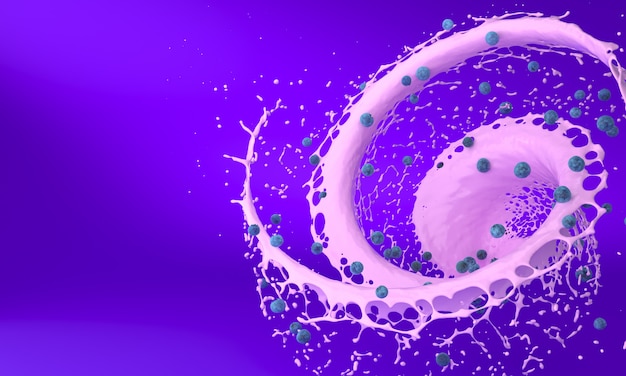The Latest Advances in Cancer Treatment: Immunotherapy and Targeted Therapies

Immunotherapy and targeted therapies represent the forefront of cancer treatment, offering precision approaches that harness the body’s immune system and target specific molecular pathways driving cancer growth.
Discover the cutting-edge world of The Latest Advancements in Cancer Treatment: Exploring Immunotherapy and Targeted Therapies. This article delves into how these innovative approaches are transforming cancer care, offering new hope and improved outcomes for patients.
Understanding Immunotherapy: Unleashing the Immune System
Immunotherapy is revolutionizing cancer treatment by leveraging the body’s own immune system to fight cancer cells. This approach differs significantly from traditional methods like chemotherapy and radiation, which can also harm healthy cells.
The core principle of immunotherapy is to enhance the immune system’s ability to recognize and destroy cancer cells. This can be achieved through various methods, including:
Checkpoint Inhibitors
Checkpoint inhibitors are drugs that block certain proteins (checkpoints) on immune cells that prevent them from attacking cancer cells. By blocking these checkpoints, the immune system can mount a stronger response against the cancer.
CAR T-Cell Therapy
Chimeric antigen receptor (CAR) T-cell therapy involves modifying a patient’s T cells (a type of immune cell) to recognize and attack their cancer cells. This process involves extracting T cells from the patient’s blood, genetically engineering them to express a CAR that targets a specific protein on cancer cells, and then infusing the modified T cells back into the patient.
- CAR T-cell therapy has shown remarkable success in treating certain types of blood cancers, such as leukemia and lymphoma.
- The therapy can cause significant side effects, including cytokine release syndrome (CRS) and neurotoxicity, which require careful management.
- Research is ongoing to expand the use of CAR T-cell therapy to other types of cancers and to develop strategies to reduce its side effects.

Immunotherapy has demonstrated significant promise across a range of cancers, from melanoma and lung cancer to Hodgkin lymphoma. However, like all treatments, it is not without its challenges. Side effects can vary from mild, such as skin rash or fatigue, to more severe, such as inflammation of organs.
The field is continually evolving, with ongoing research focused on identifying new targets, developing more effective immunotherapies, and understanding how to predict which patients are most likely to benefit. Combination therapies, which involve combining immunotherapy with other treatments like chemotherapy or radiation, are also being investigated to improve outcomes.
In summary, immunotherapy represents a significant leap forward in cancer treatment, offering new hope and improved outcomes for many patients. Its ability to harness the body’s own immune system to fight cancer makes it a powerful and potentially transformative approach.
Targeted Therapies: Precision Medicine in Action
Targeted therapies represent a cornerstone of precision medicine in oncology, focusing on specific molecular targets within cancer cells to disrupt their growth, spread, and survival. Unlike traditional chemotherapy, which can affect both cancerous and healthy cells, targeted therapies are designed to selectively attack cancer cells while sparing normal tissues.
This approach is based on understanding the genetic and molecular alterations that drive cancer development. By identifying these specific targets, researchers can develop drugs that interfere with their function, leading to more effective and less toxic treatments.
How Targeted Therapies Work
Targeted therapies work by interfering with specific molecules involved in cancer cell growth and survival. These molecules may include:
- Proteins that promote cell division
- Growth factor receptors on the cell surface
- Blood vessel growth factors
Types of Targeted Therapies
Several types of targeted therapies are currently available, including:
- Small molecule inhibitors: These drugs are designed to enter cancer cells and block the activity of specific proteins involved in cell growth and survival. An example is tyrosine kinase inhibitors (TKIs).
- Monoclonal antibodies: These lab-created antibodies are designed to attach to specific proteins on cancer cells, marking them for destruction by the immune system.

Targeted therapies have shown significant success in treating various cancers, including breast cancer, lung cancer, and melanoma. For example, HER2-targeted therapies have revolutionized the treatment of HER2-positive breast cancer, significantly improving outcomes for these patients.
However, like all cancer treatments, targeted therapies can have side effects. These may include skin rashes, diarrhea, fatigue, and high blood pressure. Resistance to targeted therapies can also develop over time, as cancer cells may evolve new mechanisms to bypass the effects of the drug.
In conclusion, targeted therapies represent a major advance in cancer treatment, offering a more precise and effective approach to attacking cancer cells. Its ability to target specific molecular pathways makes it a more effective treatment. Ongoing research is focused on identifying new targets, developing more effective targeted therapies, and overcoming resistance mechanisms.
Combining Immunotherapy and Targeted Therapies
The convergence of immunotherapy and targeted therapies marks a significant shift in cancer treatment strategies. Combining these approaches offers the potential to enhance anti-tumor responses and improve patient outcomes by leveraging their complementary mechanisms of action.
Immunotherapy harnesses the power of the immune system to recognize and destroy cancer cells, while targeted therapies selectively inhibit specific molecular pathways driving cancer growth. When used in combination, these treatments can overcome resistance mechanisms and achieve more durable responses.
Synergistic Effects
The rationale behind combining immunotherapy and targeted therapies lies in their ability to address different aspects of cancer development. Targeted therapies can create a more favorable environment for immune cells to infiltrate and attack the tumor, while immunotherapy can amplify the anti-tumor response and prevent the development of resistance.
For example, targeted therapies that inhibit angiogenesis (the formation of new blood vessels) can normalize the tumor vasculature, improving the delivery of immune cells to the tumor microenvironment. Additionally, certain targeted therapies can increase the expression of tumor-associated antigens, making cancer cells more visible to the immune system.
Clinical Trials and Emerging Data
Numerous clinical trials are currently evaluating the combination of immunotherapy and targeted therapies in various cancer types. Early data from these trials suggest that this approach can lead to higher response rates, longer progression-free survival, and improved overall survival compared to either treatment alone.
- In melanoma, the combination of a PD-1 inhibitor (an immunotherapy drug) with a BRAF inhibitor (a targeted therapy) has shown promising results in patients with BRAF-mutated tumors.
- In lung cancer, the combination of immunotherapy with targeted therapies that inhibit EGFR or ALK has demonstrated improved outcomes in patients with these genetic mutations.
- Research is ongoing to identify biomarkers that can predict which patients are most likely to benefit from combination therapy.
Challenges remain in optimizing the combination of immunotherapy and targeted therapies. One challenge is managing the potential for increased side effects, as the combination of these treatments can sometimes lead to more immune-related adverse events.
Another challenge is identifying the optimal sequencing and dosing of these treatments. Research is needed to determine whether it is better to administer immunotherapy before, after, or concurrently with targeted therapy, as well as to identify the optimal doses of each drug.
In conclusion, the combination of immunotherapy and targeted therapies represents a promising strategy for improving cancer treatment outcomes. By leveraging the complementary mechanisms of action of these treatments, clinicians can achieve more durable responses and potentially cure some patients with advanced cancer.
The Role of Biomarkers in Guiding Treatment Decisions
Biomarkers play a crucial role in guiding treatment decisions in modern oncology. These measurable indicators can provide valuable information about a patient’s cancer, helping clinicians to select the most appropriate treatment and predict how well a patient is likely to respond.
In the context of immunotherapy and targeted therapies, biomarkers are particularly important because these treatments are not effective for all patients. By identifying biomarkers that predict response or resistance, clinicians can personalize treatment and avoid exposing patients to unnecessary side effects.
Types of Biomarkers
Several types of biomarkers are used in oncology, including:
- Genetic biomarkers: These biomarkers involve analyzing a patient’s DNA to identify mutations or other genetic alterations that may be driving cancer growth.
- Protein biomarkers: These biomarkers involve measuring the levels of specific proteins in a patient’s blood or tissue samples.
- Immune biomarkers: These biomarkers involve assessing the status of a patient’s immune system, such as the levels of immune cells or the expression of immune checkpoint proteins.
Biomarkers in Immunotherapy
Several biomarkers have been identified that can predict response to immunotherapy. For example, the expression of PD-L1, a protein that inhibits immune cell activity, has been shown to correlate with response to PD-1 inhibitors in some cancers.
Tumor mutational burden (TMB), which measures the number of mutations in a tumor’s DNA, has also been shown to predict response to immunotherapy in some cancers. Cancers with higher TMB tend to be more responsive to immunotherapy because they have more neoantigens, which are proteins that the immune system can recognize as foreign.
- Ongoing research is focused on identifying new biomarkers that can better predict response to immunotherapy, such as biomarkers that measure the diversity of the T cell receptor repertoire.
- Biomarkers are also being developed to predict which patients are most likely to experience immune-related adverse events from immunotherapy.
In targeted therapy, genetic biomarkers are commonly used to identify patients who are likely to respond to specific drugs. For example, patients with EGFR-mutated lung cancer are more likely to respond to EGFR inhibitors, while patients with BRAF-mutated melanoma are more likely to respond to BRAF inhibitors.
Resistance to targeted therapies can also be predicted by certain biomarkers. For example, the emergence of specific mutations in EGFR can lead to resistance to EGFR inhibitors in lung cancer.
In conclusion, biomarkers are essential tools for guiding treatment decisions in modern oncology. By identifying biomarkers that predict response or resistance to immunotherapy and targeted therapies, clinicians can personalize treatment and improve outcomes for patients with cancer.
Managing Side Effects
Cancer treatments, while effective, often come with side effects. Managing these side effects is a critical part of cancer care, aiming to improve the patient’s quality of life during and after treatment.
Both immunotherapy and targeted therapies have unique side effects that require careful monitoring and management.
Immunotherapy Side Effects
Immunotherapy side effects occur because the treatment boosts the immune system, which can sometimes attack healthy tissues. These side effects are often referred to as immune-related adverse events (irAEs). Common irAEs include:
- Skin rashes
- Diarrhea
- Fatigue
- Inflammation of organs (such as the lungs, liver, or kidneys)
Targeted Therapy Side Effects
The side effects of targeted therapies vary depending on the specific drug and the target it inhibits. Common side effects include:
- Skin rashes
- Diarrhea
- Fatigue
- High blood pressure
Strategies for managing side effects may include:
- Medications to relieve symptoms (such as anti-diarrheal drugs or corticosteroids to reduce inflammation)
- Lifestyle modifications (such as diet changes or exercise)
- Supportive care (such as counseling or support groups)
Communication between patients and clinicians is essential for effective side effect management. Patients should report any new or worsening symptoms to their healthcare team as soon as possible.
In summary, managing side effects is a vital part of cancer care. By carefully monitoring and addressing side effects, healthcare providers can help patients maintain their quality of life during and after cancer treatment.
Future Directions and Emerging Technologies
Cancer treatment is a rapidly evolving field, with ongoing research and development efforts focused on improving existing therapies and developing new approaches. Several exciting future directions and emerging technologies are poised to transform cancer care in the coming years.
These include:
- Personalized cancer vaccines: These vaccines are designed to stimulate the immune system to attack cancer cells based on the unique mutations present in a patient’s tumor.
- Adoptive cell therapies: These therapies involve modifying a patient’s immune cells to recognize and attack cancer cells. In addition to CAR T-cell therapy, other types of adoptive cell therapies, such as tumor-infiltrating lymphocyte (TIL) therapy, are being developed.
- Oncolytic viruses: These viruses are genetically engineered to selectively infect and destroy cancer cells while sparing normal tissues.
Nanotechnology is another promising area of research in cancer treatment. Nanoparticles can deliver drugs directly to tumor cells, increasing their effectiveness and reducing side effects. Nanoparticles can also be used to image tumors and monitor treatment response.
### Artificial Intelligence
Artificial intelligence (AI) is also playing an increasingly important role in cancer care. AI algorithms can analyze large datasets of patient information to identify patterns and predict treatment outcomes. AI can also assist in the development of new drugs and diagnostic tools.
Research is also focused on identifying new targets for cancer therapy. By understanding the molecular mechanisms that drive cancer development, researchers can develop new drugs that interfere with these processes.
- Advances in genomics and proteomics are helping to identify new targets for cancer therapy.
- New drug delivery systems are being developed to improve the effectiveness of cancer treatments and reduce side effects.
In conclusion, cancer treatment is a rapidly evolving field with numerous exciting future directions and emerging technologies. These advances hold the promise of improving outcomes for patients with cancer and transforming cancer care in the years to come.
| Key Point | Brief Description |
|---|---|
| 🎯 Targeted Therapies | Precisely target cancer cells, reducing harm to healthy tissues. |
| 🛡️ Immunotherapy | Boosts the immune system to fight cancer, offering long-term control. |
| 🔬 Biomarkers | Guide personalized treatments, improving effectiveness and reducing side effects. |
| 🧬 Future Tech | Includes personalized vaccines, AI, and nanotechnology for advanced treatment strategies. |
Frequently Asked Questions
▼
Immunotherapy is a type of cancer treatment that helps your immune system fight cancer. It works by boosting or changing your immune system so it can find and attack cancer cells better.
▼
Targeted therapies attack specific parts of cancer cells, while chemotherapy drugs attack all rapidly dividing cells, cancerous and non-cancerous. This makes targeted therapies more precise and often less toxic.
▼
Common side effects include skin rashes, fatigue, diarrhea, and inflammation of organs. These side effects are caused by the immune system attacking healthy tissues in the body.
▼
Yes, combining these approaches can enhance anti-tumor responses by leveraging their complementary mechanisms. This combination is often used in clinical trials to improve patient outcomes.
▼
Biomarkers help predict how well a patient will respond to therapy. This helps doctors personalize cancer treatment and avoid unnecessary side effects by choosing the most effective options.
Conclusion
The landscape of cancer treatment is rapidly evolving, with immunotherapy and targeted therapies at the forefront. These innovative approaches offer new hope, improved outcomes, and a more personalized approach to cancer care, promising a future where cancer is treated with greater precision and efficacy.
